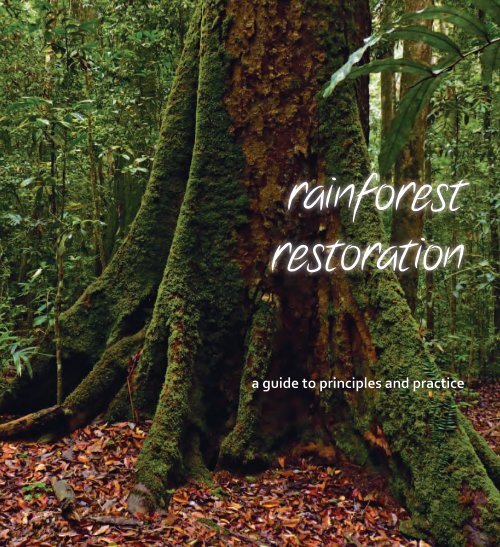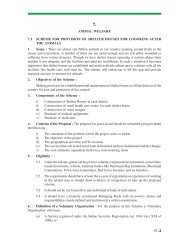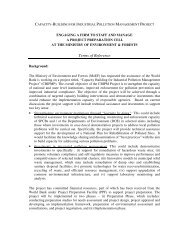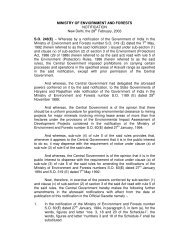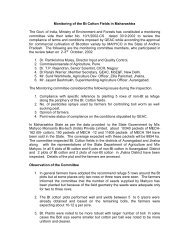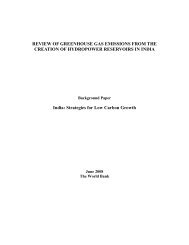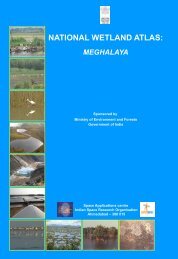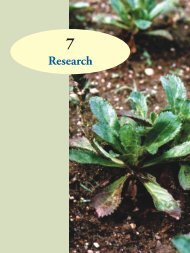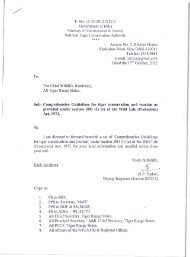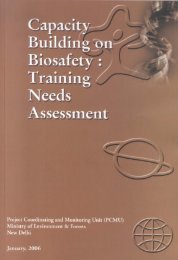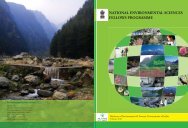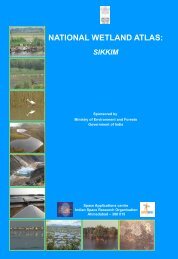rainforest restoration - Ministry of Environment and Forests
rainforest restoration - Ministry of Environment and Forests
rainforest restoration - Ministry of Environment and Forests
You also want an ePaper? Increase the reach of your titles
YUMPU automatically turns print PDFs into web optimized ePapers that Google loves.
ainforest<strong>restoration</strong>a guide to principles <strong>and</strong> practicedivya mudappa <strong>and</strong> t r shankar raman
Suggested CitationMudappa, D. <strong>and</strong> Raman, T. R. S. 2010. Rainforest Restoration: AGuide to Principles <strong>and</strong> Practice. Nature Conservation Foundation,Mysore.This text <strong>of</strong> this document is licensed underCreative Commons Attribution-NonCommercial-ShareAlike 3.0Copyright for images remain with the respective photographers.AcknowledgementsWe are extremely grateful to M. An<strong>and</strong>a Kumar for his unwaveringhelp <strong>and</strong> support in all aspects <strong>of</strong> the <strong>restoration</strong> project. We arealso grateful to the plantation companies partnering with NCF onthe <strong>rainforest</strong> project on the Valparai plateau: our current partnersParry Agro Industries Ltd <strong>and</strong> Tata C<strong>of</strong>fee Ltd, <strong>and</strong> earlier partnersTea Estates India Ltd <strong>and</strong> BBTC Ltd. We are grateful to the TamilNadu Forest Department, the Field Director, Range Forest Officers,<strong>and</strong> other staff <strong>of</strong> the Anamalai Tiger Reserve for their support.Our field staff, Dinesh, Kannan, Silamban, Sathish, Murthy, <strong>and</strong>Krishnan, have also contributed immensely to the execution <strong>of</strong>this project. A large number <strong>of</strong> students, volunteers, colleagues,<strong>and</strong> friends have also helped us over the years in fieldwork <strong>and</strong>contributed to our learning from the project.Financial supportThis publication was financially supported by the Ecosystem GrantsProgramme <strong>of</strong> the IUCN National Committee <strong>of</strong> The Netherl<strong>and</strong>s(IUCN-NL).DesignPavithra Sankaran / pavithra@me.comAll photographs by authors unless otherwise stated.Contents page (Malabar trogon): Kalyan Varmanatureconservationfoundation
contentsTropical <strong>rainforest</strong>: an introduction 1Restoration: principles <strong>and</strong> guidelines 7Rainforest <strong>restoration</strong> in the Western Ghats: an overview 21Rainforest <strong>restoration</strong> in the Western Ghats: practical aspects 25Gallery: before <strong>and</strong> after <strong>restoration</strong> 36A <strong>restoration</strong> glossary 38References 40
6tropical <strong>rainforest</strong>: an introduction
1Among all forest types on Earth, the greatest diversity<strong>of</strong> living organisms is found in the tropical <strong>rainforest</strong>.Also called tropical wet evergreen forest, this forest typeoccurs in those parts around the equator with over 2,000millimetres <strong>of</strong> annual rainfall distributed over most <strong>of</strong> theyear. Dry periods with less than 60 millimetres rainfall occuronly for a few weeks at most. As a result, there is luxuriantvegetation <strong>and</strong> most trees remain green year-round.Rainforests are found in all three tropical regionsin the world: the Americas, Africa, <strong>and</strong> Asia. The famed<strong>rainforest</strong>s <strong>of</strong> the Amazon <strong>and</strong> Orinoco basins, tracts alongthe Andes <strong>and</strong> Central America, <strong>and</strong> the forests <strong>of</strong> theAtlantic coast, comprise the <strong>rainforest</strong>s <strong>of</strong> the Americas. InAfrica, the <strong>rainforest</strong>s are found primarily in the Congo basin<strong>and</strong> West Africa, besides the highly threatened <strong>rainforest</strong>sin Madagascar. Second in extent only to the range <strong>of</strong>Amazonian <strong>rainforest</strong>s, the <strong>rainforest</strong>s <strong>of</strong> tropical Asia maybe found in a great belt centred on the Malay Archipelago,but with tracts found as far west as parts <strong>of</strong> India <strong>and</strong> SriLanka all the way to the east in Papua New Guinea <strong>and</strong>northern Queensl<strong>and</strong> in Australia <strong>and</strong> Pacific isl<strong>and</strong>s. WithinIndia, tropical <strong>rainforest</strong>s are found in north-east India(along the Eastern Himalaya, in Assam, <strong>and</strong> the hill states),in the Andaman <strong>and</strong> Nicobar Isl<strong>and</strong>s, <strong>and</strong> the Western Ghatsmountain chain along the west coast <strong>of</strong> India.Left: Canopy <strong>of</strong> a <strong>rainforest</strong> from the Western Ghats | P JeganathanAbove: Fruits <strong>of</strong> the endemic Baccaurea courtallensis, a mid-storey tree
2tropical <strong>rainforest</strong>: an introductionStructureTrees <strong>and</strong> woody climbers called lianas dominate thevegetation <strong>of</strong> a tropical <strong>rainforest</strong>. A single hectare <strong>of</strong>tropical <strong>rainforest</strong> may hold from 100 to over 300 species <strong>of</strong>trees. The canopy reaches an average height <strong>of</strong> 25 metres ormore, with some emergent trees reaching up to 80 metresin height, towering over the others. The tree canopy isdense, allowing less than 10% <strong>of</strong> the sunlight to reach theforest floor. There is a great diversity <strong>of</strong> herbs, shrubs, ferns,orchids, <strong>and</strong> plants called epiphytes that grow on top <strong>of</strong> theother plants. Even tree bark <strong>and</strong> leaf surfaces are microecosystemsthat shelter a multitude <strong>of</strong> smaller plants,fungi, lichens, <strong>and</strong> mosses. The rich tapestry <strong>of</strong> vegetationsupports a diversity <strong>of</strong> animals from minute mites <strong>and</strong>springtails in the soil to elephants <strong>and</strong> hornbills. The lives<strong>of</strong> these species are closely linked to form the complex<strong>rainforest</strong> habitat.ComplexityThe complexity <strong>of</strong> the <strong>rainforest</strong> ecosystem stems fromtwo reasons. The first is structural complexity: the foresthas many layers ranging from subsoil belowground, leaflitter, to aboveground layers such as ground vegetation,understorey, mid-storey, canopy, <strong>and</strong> emergent trees. Asecond reason is the varied dependence <strong>and</strong> interactionsamong the various <strong>rainforest</strong> organisms. For example,Above: Multiple tiers <strong>of</strong> a <strong>rainforest</strong>
tropical <strong>rainforest</strong>: an introduction3there is competition for light <strong>and</strong> moisture among plants,mutualisms <strong>of</strong> pollination <strong>and</strong> seed dispersal betweenplants <strong>and</strong> animals, herbivory <strong>and</strong> predation, <strong>and</strong> dynamicinteraction below-ground between fungal mycorrhizae <strong>and</strong>the roots <strong>of</strong> plants.DynamicsIndividual trees in tropical <strong>rainforest</strong> may live for hundreds<strong>of</strong> years <strong>and</strong> to a human observer the forest may lookthe same year after year. Yet, <strong>rainforest</strong>s are dynamicecosystems. Biologists have documented intricate details<strong>of</strong> many processes such as the birth <strong>and</strong> death <strong>of</strong> <strong>rainforest</strong>plants, competition among seedlings, fluctuations withinyears <strong>and</strong> across years in the patterns <strong>of</strong> flowering <strong>and</strong>fruiting, <strong>and</strong> their corresponding influences on animalpopulations <strong>and</strong> movements.In relatively undisturbed <strong>rainforest</strong>, one majornatural dynamic process is what has been called tree fallgap dynamics. Occasionally, large <strong>rainforest</strong> trees fall,bringing down other nearby vegetation <strong>and</strong> creating agap in the dense canopy through which sunlight streamsdown to the floor. This triggers the germination <strong>of</strong> pioneertree species from seeds lying in the soil <strong>and</strong> stimulates thegrowth <strong>of</strong> many <strong>rainforest</strong> tree seedlings as well. Rapidrecovery ensues <strong>and</strong> in a matter <strong>of</strong> years, the gap closesagain with the growth <strong>of</strong> evergreen vegetation in the case<strong>of</strong> undisturbed forests <strong>and</strong> deep forest interiors.Above: Fungi play a key role in decomposition <strong>and</strong> the nutrient dynamics <strong>of</strong> <strong>rainforest</strong>s
4tropical <strong>rainforest</strong>: an introductionThreatsAround the world, tropical <strong>rainforest</strong>s are among the mostthreatened ecosystems today. Over 100 million hectaresare lost or severely degraded every decade due to humancauseddestruction. Clearing for agriculture, plantations<strong>of</strong> oil palm, tea, c<strong>of</strong>fee, <strong>and</strong> Eucalyptus, roads, reservoirs,logging for timber, extraction <strong>of</strong> minor forest produce,invasions by weedy species, grazing, fire, climate change,unplanned development <strong>and</strong> urbanisation are some <strong>of</strong> themajor threats to tropical <strong>rainforest</strong>s today. Besides directloss <strong>of</strong> forest cover (deforestation), these have resulted infragmentation (leaving remnants <strong>of</strong> forest surrounded bynon-forest habitats), <strong>and</strong> created large areas <strong>of</strong> secondaryforest (second growth or regenerating vegetation indegraded or disturbed areas).Even as thous<strong>and</strong>s <strong>of</strong> species await discovery <strong>and</strong>study in the <strong>rainforest</strong>s, the burgeoning threats continueto further endanger <strong>and</strong> drive species extinct at rapid ratesin all tropical <strong>rainforest</strong> regions. Besides reducing the area,quality, diversity, <strong>and</strong> ecosystem services <strong>of</strong> these forests,such changes also impinge negatively on myriad indigenouspeoples <strong>and</strong> tribal communities living in the <strong>rainforest</strong>saround the world.Top: Monoculture oil-palm plantations are among the greatest threats to <strong>rainforest</strong>s worldwideAbove: Linear intrusions such as roads <strong>and</strong> power lines fragment <strong>rainforest</strong>s leading to degradation <strong>and</strong> weed invasion
5reversing forest degradation:the four r’sFor reversing the loss, degradation, or denudation <strong>of</strong> forest ecosystems several approaches have been used all<strong>of</strong> which <strong>of</strong> are <strong>of</strong>ten wrongly called <strong>restoration</strong> or eco-<strong>restoration</strong>. It is important to distinguish among these:Reforestation (or afforestation): This approach, although used widely, is typically characterised by large-scaleplantation <strong>of</strong> alien (locally or nationally non-native) species such as Eucalyptus, Acacia, Pinus, Casuarina, <strong>and</strong>many timber species. Planted as single-species st<strong>and</strong>s (monocultures), these plantations have negative impactson local ecology such as invading adjoining natural forest or grassl<strong>and</strong> habitats (e. g., Acacia auriculiformis, A.mearnsii), depleting water tables (e. g., Eucalyptus), or degrading habitat for wildlife. Ecological or long-termconsiderations are conspicuously absent in such afforestation programmes that are usually aid-driven <strong>and</strong>target-oriented to cover as much area as possible with minimal effort <strong>and</strong> time. Sometimes, driven by theingenuity <strong>and</strong> needs <strong>of</strong> local people, such programmes have had the incidental effect <strong>of</strong> providing fuel wood(e.g., wattle <strong>and</strong> eucalypts) or charcoal (e. g., Prosopis juliflora) for domestic use or sale.Reclamation: This is similar to some <strong>of</strong> the afforestation programmes in that it principally uses alien speciesto overcome severe degradation or disturbance. These may be chosen for economic reasons such as timberproduction or based on ease <strong>of</strong> establishment in highly degraded areas such as mine spoils <strong>and</strong> sites where thetop soil has been lost. For instance, the alien species Acacia auriculiformis is <strong>of</strong>ten used on ab<strong>and</strong>oned mine sites.Rehabilitation: In rehabilitation, mostly native species are used in the new forest, but some alien species maybe included as they are ecologically or economically necessary. The purpose here is to bring back a semblance<strong>of</strong> function <strong>and</strong> utility to degraded sites.Restoration: Restoration is the process <strong>of</strong> returning an ecosystem to a relatively undisturbed condition as it islikely to have been prior to major disturbances or human impact. This is the preferred option if the main goal isthe conservation <strong>of</strong> biodiversity because the emphasis is on returning the original assemblage <strong>of</strong> species <strong>and</strong>forest structure to the site. Most forest <strong>restoration</strong> projects use only native species with or without the removal<strong>of</strong> alien (non-native) species <strong>and</strong> control or removal <strong>of</strong> invasive alien weeds such as Lantana camara.To keep every cog <strong>and</strong> wheel is the first precaution <strong>of</strong> intelligent tinkering.Aldo Leopold, A S<strong>and</strong> County Almanac
6<strong>restoration</strong>: principles <strong>and</strong> guidelines
8<strong>restoration</strong>: principles <strong>and</strong> guidelineson sites as they were prior to disturbance is usuallylacking. Therefore, more frequently, reference sites areselected as relatively undisturbed sites located in the samegeographical <strong>and</strong> environmental setting. These may benearby locations with similar elevation, rainfall, <strong>and</strong> soiltype, containing complete or near-complete communities<strong>of</strong> native plants <strong>and</strong> animals. For instance, many degradedareas can be restored keeping as a reference relativelyundisturbed sites within nearby protected areas such asNational Parks <strong>and</strong> Wildlife Sanctuaries.When is <strong>restoration</strong> necessary?It is a common misconception that if we strictly protect anyarea, it will naturally recover because ‘Nature knows best’.This may be true for large areas <strong>of</strong> little disturbed forests, orfor smaller patches <strong>of</strong> disturbed vegetation adjoining morecontinuous undisturbed tracts. But we now know that manyareas will not recover even after decades <strong>of</strong> protectionor if we ignore the effects <strong>of</strong> continuing disturbances. Insuch areas carefully planned intervention in the form <strong>of</strong><strong>restoration</strong> becomes necessary because:• natural recovery <strong>of</strong> the original vegetation <strong>and</strong>associated animal communities will not occur evenunder strict protection following the removal orcurtailment <strong>of</strong> disturbance factors,• natural recovery may take an enormous amount <strong>of</strong>time (decades to centuries) unless we intervene toTop: The unbroken canopy <strong>of</strong> a <strong>rainforest</strong>—a reference siteBottom: In fragmented l<strong>and</strong>scapes restoring degraded fragments can aid in biodiversity conservation
estoration: principles <strong>and</strong> guidelines9‘assist the recovery’ <strong>of</strong> the degraded site, <strong>and</strong>• meeting specific conservation goals requires the revival<strong>of</strong> specific sites within a specific time period.What kinds <strong>of</strong> sites need <strong>restoration</strong>?Restoration may be necessary in a wide variety <strong>of</strong> sites suchas areas where:• there is heavy infestation <strong>of</strong> weeds, grasses, <strong>and</strong> vines,choking natural vegetation,• the soil seed bank is depleted or lost due to historicaldisturbance such as fire <strong>and</strong> grazing,• parent trees that can produce seeds are locally extinct,as in isolated fragments,• natural forests have been replaced by monoculturetimber plantations or cash crops,• settlements, plantations, or other l<strong>and</strong>-use existedearlier but are now ab<strong>and</strong>oned,• soil nutrient status <strong>and</strong> symbiotic mycorrhizal fungalpopulations are lost or reduced,• large areas have been cleared or mined with top soillost, eroded, or depleted, or• open areas have been created due to clear-felling, fires,or l<strong>and</strong>slides.Above: Degraded forests with alien trees <strong>and</strong> shrubs may be targetted for <strong>restoration</strong>
10<strong>restoration</strong>: principles <strong>and</strong> guidelinesHow do we prioritize areas in the l<strong>and</strong>scape for<strong>restoration</strong>?Sites need to be prioritized for <strong>restoration</strong> in forestl<strong>and</strong>scapes using specific criteria based on ecological <strong>and</strong>conservation needs. This could include, for instance:• sites that are habitats <strong>of</strong> particular threatened orendemic species,• stream sides <strong>and</strong> river courses,• degraded areas within or along the edges <strong>of</strong> existingwildlife sanctuaries <strong>and</strong> reserved forests,• edges <strong>of</strong> forest fragments, adjoining plantations orother habitats• corridors linking forest fragments,• along linear intrusions such as roads, power-lineclearings, <strong>and</strong> fire-lines, <strong>and</strong>• the l<strong>and</strong> matrix (plantations, fields, streams etc.)surrounding fragments or reservesWhat is the role for protection?Protection efforts need to go h<strong>and</strong>-in-h<strong>and</strong> with<strong>restoration</strong>. Larger areas <strong>of</strong> forest, especially relativelyundisturbed forests, need continued protection. In mostsuch cases, one should not carry out <strong>restoration</strong> or plantingactivities (including gap or supplementation planting,‘assisted natural regeneration’, food species enhancement,etc.) <strong>and</strong> allow natural processes to operate.Above: Restoration may be designed for specific parts <strong>of</strong> altered l<strong>and</strong>scapes to achieve conservation goals | M D. Madhusudan
11<strong>restoration</strong> protocol:guidelines for setting targetsFrom Society for Ecological Restoration International Science <strong>and</strong> Policy Working Group:1. A legitimate <strong>and</strong> indeed important object <strong>of</strong> much ecological <strong>restoration</strong> is the reintegration <strong>of</strong> fragmentedecosystems <strong>and</strong> l<strong>and</strong>scapes, rather than focusing on just a single ecosystem. A baseline ecologicalinventory describes the salient attributes <strong>of</strong> the abiotic environment <strong>and</strong> important aspects <strong>of</strong> biodiversitysuch as species composition <strong>and</strong> community structure.2. Highest priority is best reserved for the control or extirpation <strong>of</strong> those species which pose the greatestthreats. These include invasive plant species that are particularly mobile <strong>and</strong> pose an ecological threat atl<strong>and</strong>scape <strong>and</strong> regional levels, <strong>and</strong> animals that consume or displace native species. Care should be takento cause the least possible disturbance to indigenous species <strong>and</strong> soils as exotics are removed. In someinstances, non-indigenous plants are used for a specific purpose in the <strong>restoration</strong> project, for example ascover crops, nurse crops or nitrogen fixers. Unless these are relatively short-lived, non-persistent speciesthat will be replaced in the course <strong>of</strong> succession, their eventual removal should be included in <strong>restoration</strong>plans.3. The importance <strong>of</strong> an ample recovery in species composition cannot be overstated in <strong>restoration</strong>. Allfunctional species groups must be represented if a restored ecosystem is to maintain itself.4. Many cultural ecosystems have suffered from demographic growth <strong>and</strong> external pressures <strong>of</strong> various kinds,<strong>and</strong> are in need <strong>of</strong> <strong>restoration</strong>. The <strong>restoration</strong> <strong>of</strong> such ecosystems normally includes the concomitantrecovery <strong>of</strong> indigenous ecological management practices, including support for the cultural survival <strong>of</strong>indigenous peoples <strong>and</strong> their languages as living libraries <strong>of</strong> traditional ecological knowledge. Ecological<strong>restoration</strong> encourages <strong>and</strong> may indeed be dependent upon long-term participation <strong>of</strong> local people.It’s the little things citizens do. That’s what will make the difference. My little thing is planting trees.Wangari Maathai, Nobel laureate
12<strong>restoration</strong>: principles <strong>and</strong> guidelinesIn sites selected for <strong>restoration</strong> using the criteria listedabove, we need to ensure protection from disturbancesthat led to the degradation in the first place. For instance,sites degraded by grazing or fire need to be protected fromcattle <strong>and</strong> fires. Sites degraded by fuel-wood removal <strong>and</strong>felling need to be protected from cutting <strong>of</strong> native species(although woody weeds such as Lantana may be cut <strong>and</strong>alternatives provided for local people).What are non-native or alien species?Alien species <strong>of</strong> plants or animals are those speciesintroduced intentionally or accidentally into an areawhere they did not previously occur by human activities.While some alien species fail to spread on their own,others can rapidly propagate <strong>and</strong> spread into newer areas.Such species are called invasive alien species <strong>and</strong> they<strong>of</strong>ten compete with <strong>and</strong> replace native species. Weedsare proliferating species that are usually alien <strong>and</strong> <strong>of</strong>teninvasive, which establish <strong>and</strong> propagate widely. Alienspecies are sometimes referred to as exotics. Examples<strong>of</strong> alien species in tropical Asia include Australian treespecies such as Eucalyptus spp. <strong>and</strong> some Acacia wattles,shrub species such as Lantana camara <strong>and</strong> Prosopis juliflorafrom the Americas, <strong>and</strong> trees such as Maesopsis eminii <strong>and</strong>Spathodea campanulata from Africa.Top: Mikania micrantha, the mile-a-minute weed, is 16an invasive alien climber in tropical forestsBottom: Lantana camara, a widepsread invasive in tropical <strong>rainforest</strong>s <strong>of</strong> Asia <strong>and</strong> Africa
estoration: principles <strong>and</strong> guidelines13Why should we deal with alien species?Many alien species (e.g., Eucalyptus spp., Acaciaauriculiformis, Acacia mearnsii, pines, Casuarina equisetifolia)have been planted widely, even inside wildlife sanctuaries<strong>and</strong> national parks. In addition, many herbaceous weedshave been introduced <strong>and</strong> spread due to various humanactivities <strong>and</strong> regular small-scale disturbances. Sometimesalien species have been planted as they are consideredto provide food for wildlife (e.g., Maesopsis eminii). Thesealien species have various detrimental effects on naturalecological processes, native vegetation, <strong>and</strong> many wildlifepopulations through:• Reduction in ground water table (e. g., Eucalyptus spp.)• Alteration <strong>of</strong> soil characteristics <strong>and</strong> microclimate• Suppression or alteration <strong>of</strong> native plant communities(e.g., Maesopsis eminii)• Proliferation <strong>of</strong> other weeds (e.g., Lantana camara<strong>of</strong>ten grows in the understorey <strong>of</strong> Eucalyptusplantations)• Change in forest structure <strong>and</strong> function (many alienspecies)• Invasion into surrounding l<strong>and</strong>scape (many alienspecies, Maesopsis eminii, Acacia mearnsii, Spathodeacampanulata)• Reduction in native biological diversity, particularlyaffecting specialized mature forest animal speciesTop: Alien weeds can aggressively invade into forests especially along degraded edges (in this case, Montanoa sp.)Bottom: Chromolaena odorata (aka Eupatorium), is among the top 100 most invasive species in the world
14<strong>restoration</strong>: principles <strong>and</strong> guidelinesHow do we deal with alien species?A basic principle is that one should strictly avoid plantingalien species close to or within wildlife conservation areas.Alien species need to be dealt with care. Most <strong>restoration</strong>programmes employ means <strong>of</strong> targeted removal orsuppression <strong>of</strong> invasive alien species. These may includecutting <strong>and</strong> uprooting <strong>of</strong> rootstock as in the case <strong>of</strong> Lantanacamara, h<strong>and</strong>-weeding, pressing down <strong>of</strong> grasses withboards, or even herbicide application on specific weeds.Care should be taken in such weeding operations not todisturb soil or native vegetation as disturbances can leadto further proliferation <strong>of</strong> weeds. Occasionally some alienspecies may prove useful in <strong>restoration</strong>, if they are noninvasive,by providing partial shade or leaf litter that mayact as mulch.Can monoculture plantations be ecologically restored?Experience from <strong>restoration</strong> projects <strong>and</strong> regenerationstudies indicate that it is possible to restore <strong>rainforest</strong>s insites currently dominated by alien species. In sites underEucalyptus <strong>and</strong> Maesopsis tree canopies, for instance,<strong>restoration</strong> efforts by removal <strong>of</strong> herbaceous understoreyweeds (without cutting native vegetation) <strong>and</strong> planting <strong>of</strong>a diversity <strong>of</strong> native species has proved quite successful.Some monoculture plantations, if protected fromdisturbances such as fire, develop a diverse regeneration<strong>of</strong> native plant species when they are close to seed sources(natural forests). The diversity <strong>of</strong> species is, however, usuallyTop: Alien weeds such as Lantana camara carefully cut <strong>and</strong> removed without damage to native plants in a <strong>restoration</strong> siteBottom: Recovery <strong>of</strong> diversity in monoculture plantaions including Eucalyptus can take place both through regeneration as well as ecological <strong>restoration</strong> |M. D. Madhusudan
estoration: principles <strong>and</strong> guidelines15lower than in relatively undisturbed forests.How do we get seedlings for <strong>restoration</strong>?A plant nursery where an appropriate diversity <strong>of</strong> nativespecies are raised is a critical need in any <strong>restoration</strong>programme. Seed collection <strong>and</strong> nursery development <strong>and</strong>maintenance are year-round activities as the plants requirecontinuous nurture <strong>and</strong> because seeds <strong>of</strong> different treesbecome available at different times within a year. Matureseeds fallen on the ground may be collected from forestedges or along forest trails or roads. All seeds should befrom plants in the same area <strong>and</strong> same vegetation type(species occurring in the reference sites). If there are alot <strong>of</strong> seedlings along trails or roads that are likely to getrun over or cleared during road maintenance, these canalso be collected as ‘wildlings’ or ‘rescued saplings’ fornurture in the nursery. One should avoid collecting seeds orseedlings from within forest interiors or fragments as it maynegatively affect the natural process <strong>of</strong> regeneration, <strong>and</strong>forest dynamics <strong>and</strong> recovery in case <strong>of</strong> forest fragments.How do we select species for <strong>rainforest</strong><strong>restoration</strong>?The primary protocol to be used for ecological <strong>restoration</strong><strong>of</strong> <strong>rainforest</strong> is mixed native species planting <strong>of</strong> <strong>rainforest</strong>trees (with some lianas <strong>and</strong> shrubs). The species to beplanted should be native species typical to the vegetationtype, region, <strong>and</strong> altitude, as evidenced from theirTop: Developing a native plant species nursery is a crucial part <strong>of</strong> most ecological <strong>restoration</strong> programmes | M. D. MadhusudanBottom: Native species typical to the particular vegetation type need to be used in <strong>restoration</strong>; Cullenia exarillata being an obvious choice for midelevation<strong>rainforest</strong>s in the southern Western Ghats
16<strong>restoration</strong>: principles <strong>and</strong> guidelinesoccurrence in the reference site. Factors such as slope,aspect, distance to water, canopy openness, <strong>and</strong> soil statusneed to considered in the selection <strong>of</strong> which seedling is tobe planted at a specific location within a <strong>restoration</strong> site.Two main species selection methods are used in <strong>rainforest</strong><strong>restoration</strong>:Framework species method: This involves the planting<strong>of</strong> one or, more <strong>of</strong>ten, a few species <strong>of</strong> pioneer <strong>and</strong> midsuccessionalspecies along with a mixture <strong>of</strong> mature forestspecies. Framework species are those that establish <strong>and</strong>grow well in disturbed areas, that produce flowers <strong>and</strong>fruits that attract animals relatively quickly, that haverobust germination <strong>and</strong> vigorous production <strong>of</strong> branches<strong>and</strong> litter. One can plant ‘keystone species’ such as Ficusspecies, which attract many frugivorous animals to theirfruit resources. The main advantages <strong>of</strong> this method arethat it involves only one planting, it is self-sustaining, <strong>and</strong> itincorporates the need for attracting <strong>and</strong> sustaining wildlife<strong>and</strong> linking them with recovery <strong>of</strong> natural dynamics such asseed dispersal <strong>and</strong> regeneration. The method is best suitedfor sites that are close to other seed sources or habitats withpopulations <strong>of</strong> mammals <strong>and</strong> birds that can colonise <strong>and</strong>bring seeds into the <strong>restoration</strong> site.Maximum diversity method: This involves the reestablishment<strong>of</strong> as many <strong>of</strong> the original pre-disturbancespecies as possible. In sites with few adjoining seed sourcesAbove: Macaranga peltata is a common, fast-growing pioneer that may regenerate or be planted in highly open sites
estoration: principles <strong>and</strong> guidelines17or for plant species that are locally extinct or have poordispersal, this may be the only means to bring back plantpopulations in <strong>restoration</strong> sites. This method involves morelabour <strong>and</strong> maintenance (e. g., to raise seedlings, monitorsurvival, weeding) <strong>and</strong> may be slower as many matureforest species are likely to have slow growth rates. Also,recolonisation by animals may be poorer or slower if thesites are highly isolated. Although this is a highly preferableapproach where the major goal is conservation <strong>of</strong> biologicaldiversity, because <strong>of</strong> relatively high cost <strong>and</strong> effort it willbe most useful in select situations <strong>and</strong> in key regions forbiodiversity conservation.What are the benefits <strong>of</strong> ecological <strong>restoration</strong>?Ecological <strong>restoration</strong> can have multiple benefits:• Conserving native biological diversity• Increasing wildlife habitat• Enhancing forest connectivity in fragmentedl<strong>and</strong>scapes• Provision <strong>of</strong> ecosystem services (such as watershedbenefits, carbon sequestration)• Provision <strong>of</strong> non-timber forest produce to indigenousforest people• Enhancing aesthetic values <strong>of</strong> the l<strong>and</strong>scape• Restoring cultural links between people <strong>and</strong> natureAbove: Besides enhancing biodiversity, ecological <strong>restoration</strong> can provide substantial watershed <strong>and</strong> climatic benefits
18indicators <strong>of</strong> successAccording to the Society for Ecological Restoration International Science <strong>and</strong> Policy Working Group, anecosystem has recovered <strong>and</strong> is restored when:1. It contains sufficient biotic <strong>and</strong> abiotic resources to continue its development without further assistance orsubsidy.2. It is suitably integrated into a larger ecological matrix, l<strong>and</strong>scape, or contiguous ecosystems, with which itinteracts in terms <strong>of</strong> biotic <strong>and</strong> abiotic flows <strong>and</strong> cultural interactions.3. It contains a characteristic assemblage <strong>of</strong> the species that occur in the reference ecosystem <strong>and</strong> thatprovide appropriate community structure.4. It consists <strong>of</strong> indigenous species to the greatest practicable extent.5. All functional groups necessary for the continued development <strong>and</strong>/or stability are represented or, if theyare not, the missing groups have the potential to colonize by natural means (corridors, river systems, row<strong>of</strong> trees).6. The physical environment <strong>of</strong> the restored ecosystem is capable <strong>of</strong> sustaining reproducing populations <strong>of</strong>the species necessary for its continued stability or development along the desired path.7. Potential threats to the health <strong>and</strong> integrity <strong>of</strong> the restored ecosystem from the surrounding l<strong>and</strong>scapehave been eliminated or reduced as much as possible.8. The restored ecosystem is self-sustaining to the same degree as its reference ecosystem, <strong>and</strong> has thepotential to persist indefinitely under existing environmental conditions. Nevertheless, aspects <strong>of</strong> itsbiodiversity, structure <strong>and</strong> functioning may change as part <strong>of</strong> normal ecosystem development, <strong>and</strong> mayfluctuate in response to normal periodic stress <strong>and</strong> occasional disturbance events <strong>of</strong> greater consequence.As in any intact ecosystem, the species composition <strong>and</strong> other attributes <strong>of</strong> a restored ecosystem mayevolve as environmental conditions change.Too <strong>of</strong>ten, reforestation projects … become dominated by numerical targets <strong>and</strong> quotas, with ‘success’ measured interms <strong>of</strong> seedlings planted, rather than forest established.~ Richard T. Corlett, The Ecology <strong>of</strong> Tropical East Asia
19How many key species can a <strong>rainforest</strong> lose before orderbecomes chaos, before the community collapses in anavalanche <strong>of</strong> extinctions?~ George Schaller, A Naturalist <strong>and</strong> Other Beasts
20<strong>rainforest</strong> <strong>restoration</strong> in thewestern ghats: an overview
ainforest <strong>restoration</strong> in the western ghats: an overview21An ancient hill range, running along the west coast <strong>of</strong> Indiafor 1,600 kilometres from the southern tip <strong>of</strong> the IndianPeninsula to the River Tapti in the North, the Western Ghatsis a global biodiversity hotspot along with Sri Lanka.The Western Ghats has a tropical climate thatshows pronounced variation along north–south, east–west, <strong>and</strong> altitudinal gradients. In general, the vegetationbecomes drier as one progresses from west to east (rainshadow) across the hills, more seasonal as one goes fromsouth to north, <strong>and</strong> cooler <strong>and</strong> wetter as one ascendsthe hills. Thus, an impressive range <strong>of</strong> natural vegetationtypes is found in the Western Ghats from tropical dry thorn<strong>and</strong> deciduous forests to moist deciduous forests, semievergreen,<strong>and</strong> wet evergreen forests in progressivelywetter areas. There are also unique types such as theMyristica swamps, the bamboo <strong>and</strong> cane brakes, <strong>and</strong> themontane grassl<strong>and</strong>s <strong>and</strong> shola forests.In the southern Western Ghats, the Anamalai hillsregion is particularly special as it contains the entire range<strong>of</strong> natural vegetation types that one may encounter in thesouthern Western Ghats from dry thorn to shola forest,<strong>and</strong> reed brakes to grassl<strong>and</strong>s. The tropical wet evergreenforests <strong>of</strong> the Western Ghats, are broadly classified intolow- (mostly below < 700 m), medium- (700–1,400 m), <strong>and</strong>high-elevation (>1,400 m) types. In planning ecological<strong>restoration</strong>, it is important to identify the correct type<strong>of</strong> natural vegetation in the region <strong>and</strong> know theircharacteristic plant <strong>and</strong> animal species.Tropical <strong>rainforest</strong>s <strong>of</strong> the Western GhatsAmong these vegetation types, the wet evergreen forestsor <strong>rainforest</strong>s are special. These <strong>rainforest</strong>s occur all alongGhats from Maharashtra to Kerala. Some <strong>of</strong> the best tractsare found in the southern Western Ghats, the region south <strong>of</strong>the Palghat gap (a 40 km-wide break in the mountain range)that contains some <strong>of</strong> the highest peaks <strong>and</strong> vast stretches<strong>of</strong> mature evergreen forests. These forests also containmuch <strong>of</strong> the plant <strong>and</strong> animal diversity, particularly endemicspecies (species not found anywhere else in the world).Left: An Elaeocarpus serratus tree towers into the canopy <strong>of</strong> a <strong>rainforest</strong> in southern India | Kalyan VarmaAbove: The plants <strong>of</strong> the <strong>rainforest</strong> are exquisitely adapted in morphology <strong>and</strong> ecology to life in the tropical environment
22major <strong>rainforest</strong> types in thesouthern western ghatsAt least five major types <strong>of</strong> wet evergreen forest or <strong>rainforest</strong> are found in the Anamalai hills region dependingon elevation above sea level <strong>and</strong> aspect (eastern versus western slopes <strong>of</strong> the main hill range):1. Plains <strong>and</strong> low elevation wet evergreen forest: This type is found at elevations below 700 m, particularlyon the western side <strong>of</strong> the Ghats. It is characterized by tall dipterocarp trees including many endemics:Dipterocarpus indicus <strong>and</strong> Dipterocarpus bourdilloni, Vateria indica, Hopea ponga. Historically, much <strong>of</strong> thistype has been lost, especially in the plains. Examples exist in areas near Manamboli <strong>and</strong> Vazhachal.2. Medium elevation wet evergreen forest: This is the most extensive wet evergreen type in the Anamalaihills today, found at elevations between 700 m <strong>and</strong> 1,400 m. It is characterized by tree species such asCullenia exarillata, Mesua ferrea, Palaquium ellipticum, <strong>and</strong> Myristica dactyloides. Much <strong>of</strong> this <strong>rainforest</strong>type occurs as fragments, including on private l<strong>and</strong>s in the Valparai plateau <strong>and</strong> Nelliampathy hills.Examples <strong>of</strong> this type can be found at Iyerpadi near Valparai, near Uralikal-Surulimalai <strong>and</strong> nearMalakkiparai.3. Transitional forests with Lauraceae: As we move higher, between 1,400 m <strong>and</strong> 1,700 m, the above foresttype changes to montane forest through this transitional forest type. This type has many Lauraceae speciessuch as Persea macrantha, Neolitsea sp. <strong>and</strong> Litsea sp. An example is Akkamalai forest.4. Shola forest: The typical shola forest, a kind <strong>of</strong> stunted montane wet evergreen forest, is found atelevations above 1,800 m. This type is found only in the hills <strong>of</strong> the Nilgiris, Anamalais, <strong>and</strong> Palnis in theWestern Ghats. Characteristic trees include Schefflera racemosa, Michelia nilagirica, <strong>and</strong> Prunus ceylanica.Examples are seen in Konalar-Grass Hills <strong>and</strong> in Eravikulam.
23<strong>rainforest</strong> <strong>restoration</strong> in the western ghats: an overviewcharacteristic tree species in <strong>rainforest</strong>sat different altitudesLow elevation forestDipterocarpus indicusHopea parvifloraPalaquium ellipticumPalaquium bourdilloniMesua ferreaVateria indicaCalophyllum polyanthumPoeciloneuron indicumMyristica dacytloidesHoligarna beddomeiBombax ceibaDrypetes longifoliaFahrenheitia zeylanicaBaccaurea courtallensisHarpullia arboreaFilicium decipiensPolyalthia fragransCleidion spiciflorumKnema attenuataDimocarpus longanHydnocarpus pent<strong>and</strong>raReinwardtiodendron anamallayanumMid elevation forestCullenia exarillataMesua ferreaPalaquium ellipticumMyristica dactyloidesElaeocarpus tuberculatusSyzygium gardneriOrmosia travancoricaLitsea oleoidesBisch<strong>of</strong>ia javanicaArtocarpus heterophyllusOlea dioicaDrypetes wightii/malabaricaTrichilia connaroidesCinnamomum malabathrumActinodaphne angustifoliaOreocnide integrifoliaAntidesma menasuGomph<strong>and</strong>ra coriaceaSemecarpus travancoricaPersea macranthap Top Storey pq Mid Storey qHigh elevation forestSyzygium densiflorumBhesa indicaGordonia obtusaLitsea bourdilloniCryptocarya sp.Casearia rubescensActinodaphne malabaricaPrunus ceylanicaDysoxylum binectariferumElaeocarpus serratusArdisia rhomboideaGomph<strong>and</strong>ra coriaceaSymplocos racemosaSymplocos kanaranaIson<strong>and</strong>ra lanceolataGarcinia kovaGarcinia pictoriusPersea macranthaAntidesma menasuOreocnide integrifoliaMontane forestSyzigium densiflorumCeltis timorensisLitsea wightianaCinnamomum wightiiPrunus ceylanicaMeliosma simplicifoliaIlex wightianaMichelia nilagiricaSchefflera racemosaElaeocarpus variabilisChionanthus ramifloraGomph<strong>and</strong>ra coriaceaEuonymus crenulatusNothapodytes nimmonianaMemecylon r<strong>and</strong>erianumArdisia rhomboideaMahonia leschenaultiiPavetta brevifloraIxora notonianaLasianthus venulosusLasianthus acuminatusPsychotria nilgiriensis
24<strong>rainforest</strong> <strong>restoration</strong> in thewestern ghats: practical aspects
25components <strong>of</strong> a <strong>rainforest</strong> <strong>restoration</strong> projectIdentifying <strong>and</strong> prioritizing sites for <strong>restoration</strong> in a l<strong>and</strong>scapeIdentifying reference sites <strong>and</strong> documenting ecological attributesDESIGNEstablishment <strong>of</strong> native plant species nurserySite preparation, including weed removalRestoration plantingIMPLEMENTATIONRestoration monitoring: plants <strong>and</strong> animalsAssessing success <strong>and</strong> course correctionLeft: Newly planted Ormosia travancorica seeds in a <strong>rainforest</strong> species nursery | Pavithra Sankaran
26the anamalai hills experienceSuccessful models <strong>of</strong> <strong>rainforest</strong> <strong>restoration</strong> have emergedfrom Australia <strong>and</strong> Thail<strong>and</strong>, Brazil <strong>and</strong> India, in recent times(see References). While many learnings can be gleanedfrom these projects, ecological <strong>restoration</strong> requires muchtrial-<strong>and</strong>-error, <strong>and</strong> learning from the errors. Some practicalaspects <strong>of</strong> <strong>restoration</strong> gained from a project aiming toecologically restore degraded <strong>rainforest</strong> fragments inthe Valparai plateau <strong>of</strong> the Anamalai hills are presentedhere. Over the last ten years, this project has worked inpartnership with tea <strong>and</strong> c<strong>of</strong>fee plantation companies torestore degraded sites in twelve <strong>rainforest</strong> fragments lyingwithin their estates. More than 160 native tree <strong>and</strong> lianaspecies were raised in a <strong>rainforest</strong> plant nursery, planted out<strong>and</strong> monitored in this <strong>restoration</strong> effort.Nursery protocolsNursery infrastructure establishmentThe important parts <strong>of</strong> a nursery include:• A 0.5-1 m deep trough or raised bed <strong>of</strong> well aerated soilwhich can be used to plant small seeds such as Ficus,<strong>and</strong> most <strong>of</strong> the pioneer species.• Beds <strong>of</strong> nursery sleeves (at least 15 cm tall) filled withsoil in the proportion <strong>of</strong> 1:1:6 <strong>of</strong> s<strong>and</strong>, organic compost,<strong>and</strong> soil, respectively.• A rodent-pro<strong>of</strong> enclosure built <strong>of</strong> wire-mesh to protectsome species whose seeds are attacked by rats <strong>and</strong>squirrels.Top: Beginnings—a Bhesa indica seed germinates in the nursery | S. U. SaravanakumarBottom: Seeds <strong>of</strong> some species may be protected from rats <strong>and</strong> squirrels in the nursery using simple wire-mesh enclosures
ainforest <strong>restoration</strong> in the western ghats: practical aspects27• Shade netting <strong>of</strong> 90%, 75%, <strong>and</strong> 50% shading. Theseare required for various stages between seed planting<strong>and</strong> seedling growth. If suitable tree canopy isavailable, shade netting may not be required.Seed collection <strong>and</strong> identification <strong>of</strong> speciesSince the aim <strong>of</strong> the <strong>restoration</strong> programme is to reversethe trends <strong>of</strong> degradation, certain precautions are <strong>of</strong> utmostimportance while establishing the seed <strong>and</strong> sapling bank forthe nursery. These include:• Fresh seeds fallen on the ground have to be collectedonly from the edges <strong>of</strong> forests, along trails or roadsgoing through or along the edges <strong>of</strong> forests.• Collecting seeds or seedlings from within the forests(even if they are fragments) will negatively affect thenatural process <strong>of</strong> regeneration <strong>and</strong> forest dynamics<strong>and</strong> recovery in case <strong>of</strong> forest fragments. This woulddefeat the purpose <strong>of</strong> <strong>restoration</strong>.• Match seeds with fruit <strong>and</strong> leaf specimens in the fielditself <strong>and</strong> the species should be identified using reliableregional floras <strong>and</strong> field guides.• For each species, seeds should be collected from asmany different parent trees as possible to maximizegenetic diversity.• All seeds should be from trees in the same area <strong>and</strong>same vegetation type. For example, one shouldnot collect seeds from trees in the Nilgiris range forTop: If st<strong>and</strong>ing trees are unavailable, shade nets may be used to provide the required shade for nursery seedlingsBottom: Seeds <strong>of</strong> a large diversity <strong>of</strong> <strong>rainforest</strong> species are best collected from roads <strong>and</strong> trails along forest edges
ainforest <strong>restoration</strong> in the western ghats: practical aspects29predated (based on past knowledge or field experience)<strong>and</strong> these have to be planted in the rodent-pro<strong>of</strong>enclosure only.• Sometimes seedlings tend to get browsed by snailsor hare. These also can be protected largely within anursery enclosure.• Although water is very important, sleeves should notremain waterlogged.• Weeds have to be regularly removed from the sleevescontaining seeds or seedlings, taking care that theroots <strong>of</strong> the seedlings are not damaged. Weedscompete with seeds <strong>and</strong> seedlings for nutrients <strong>and</strong>affect their growth.• An occasional caterpillar or most other pests need notbe considered a major problem in most cases.• Use <strong>of</strong> pesticides is usually unnecessary. If the shadeis managed well, based on the seasons, even fungalattacks can be avoided without the use <strong>of</strong> fungicides.• Water is a major limiting factor for the germination <strong>and</strong>growth <strong>of</strong> seedlings. Therefore, in the first few weeks/months (depending on the species), they have to bewatered everyday, being mostly wet evergreen forestor montane shola species.• Seedlings earmarked for planting in the followingseason may be watered less frequently during theperiod <strong>of</strong> hardening.Top: Small-seeded species such as the Bisch<strong>of</strong>ia javanica here may be germinated in soil beds <strong>and</strong> later transplantedBottom: Seedlings are stacked in the nursery for easy care <strong>and</strong> monitoring; mixed-species collections may help reduce pest <strong>and</strong> disease outbreaks
30<strong>rainforest</strong> <strong>restoration</strong> in the western ghats: practical aspectsSite preparationThe boundaries <strong>of</strong> each <strong>restoration</strong> site should be measured<strong>and</strong> clearly demarcated. Invasive weeds such as Lantanacamara, Chromolaena odorata (Eupatorium odoratum), <strong>and</strong>Mikania sp. should be cut with machetes <strong>and</strong> all Lantanacamara uprooted with mattocks one to four months priorto planting. Two practices should be strictly followedduring weed clearing. First, take special care not to cut anynaturally regenerating native vegetation, including shrubs<strong>and</strong> climbers, found growing amidst the weeds. Second,larger (>1 cm girth) woody stems <strong>of</strong> Lantana camara may becut into small lengths <strong>and</strong> removed outside the fragment toprevent their sprouting. The people in nearby settlementscan also use this as fuel-wood. The finer cut stems <strong>and</strong> allgreen leafy material should be left on the site to form amat-like ground layer to avoid soil exposure <strong>and</strong> erosion.Selection <strong>of</strong> seedlingsPlanted seedlings need to be at least 45 cm – 75 cm tallat the time <strong>of</strong> planting. The seedlings are hardened in thenursery through regular exposure to direct sun <strong>and</strong> reducedwatering for 3 – 4 months prior to planting. A subset <strong>of</strong>seedlings can be raised in larger ‘jumbo’ sleeves to largesapling size (c. 1.5 m tall) for planting. Large seedlings maybe expected to better withst<strong>and</strong> episodes <strong>of</strong> grazing <strong>and</strong>drought.Top: A <strong>restoration</strong> site may require fencing <strong>and</strong> targeted removal <strong>of</strong> weeds before plantingBottom: Seedlings <strong>of</strong> appropriate native species for each site are selected <strong>and</strong> transported to the planting site
ainforest <strong>restoration</strong> in the western ghats: practical aspects31tree species <strong>of</strong> mid-elevation <strong>rainforest</strong>s for <strong>restoration</strong> plantingDysModerate to high shadeHighly degraded open areasAlong streams <strong>and</strong> swampsFastMediumSlow
32<strong>rainforest</strong> <strong>restoration</strong> in the western ghats: practical aspectsPlanting protocolSeedlings are planted in pits <strong>of</strong> around 10 cm – 15 cmdiameter <strong>and</strong> 45 cm depth. At the time <strong>of</strong> planting, theyare also provided with fertilizer (circa 100 g organic manuremixed with the soil <strong>and</strong> 25 g rock phosphate on the sides<strong>and</strong> bottom <strong>of</strong> the pit) <strong>and</strong> with a layer <strong>of</strong> litter mulcharound the base. All seedlings may be tagged conspicuouslyto be located easily for survival monitoring. The seedlingsare planted at a spacing <strong>of</strong> 1.5 m to 3 m (to facilitatemonitoring) based on the density <strong>of</strong> existing seedlings <strong>and</strong>saplings at the site, the size <strong>of</strong> the site, <strong>and</strong> the size <strong>and</strong>availability <strong>of</strong> seedlings.Weeding <strong>and</strong> plot maintenanceSpecial care should be taken not to cut any naturallyregenerating native vegetation, including shrubs <strong>and</strong>climbers. H<strong>and</strong>-weeding, using sickles or machetes, maybe preferred. Indigenous tribal people may be employedfor the task as they are skilled in the task <strong>and</strong> in identifyingnative versus non-native species. Invasive weeds such asLantana camara, Chromolaena odorata, <strong>and</strong> Mikania sp. maybe cut with machetes <strong>and</strong> all Lantana camara regeneratingmay be uprooted by h<strong>and</strong> or with mattocks. Post-plantingh<strong>and</strong>-weeding may be needed three to six times withinthe site during the first year <strong>and</strong> two to three times in thesecond year after planting.Top: Digging <strong>of</strong> pits for planting at a <strong>restoration</strong> siteBottom: A <strong>rainforest</strong> sapling is planted <strong>and</strong> mulched
ainforest <strong>restoration</strong> in the western ghats: practical aspects33FertilizationAlthough growth rates <strong>of</strong> seedlings vary substantiallyaccording to species, in most cases providing plantedseedlings with fertilizer at regular intervals over the firsttwo years will help speed up vegetative growth. St<strong>and</strong>ardnitrogen-phosphorous-potassium (NPK) mixtures <strong>and</strong>dosages may be used for this purpose.Monitoring protocolMonitoring <strong>restoration</strong> efforts is very important. It involvesmonitoring at regular intervals (every six months orannually) various aspects such as: seedling survival (byrecording survival <strong>of</strong> tagged seedlings), regeneration(through vegetation plots), <strong>and</strong> recovery <strong>of</strong> forest structure<strong>and</strong> function, <strong>and</strong> animal population <strong>and</strong> community,following st<strong>and</strong>ard methods <strong>of</strong> sampling. It is useful <strong>and</strong>illustrative to establish specific locations (photo-points)from where the site can be photographically monitoredover time. Such photo-point monitoring can illustratechanges in sites as they were before <strong>and</strong> then after<strong>restoration</strong>. One can use information from monitoringas indicators <strong>of</strong> <strong>restoration</strong> success <strong>and</strong> plan coursecorrections.Above: Research <strong>and</strong> monitoring <strong>of</strong> native <strong>and</strong> alien plant communities, regeneration, <strong>and</strong> seedling survival are crucial components <strong>of</strong> ecological<strong>restoration</strong> projects as are long-term monitoring <strong>of</strong> recovery <strong>of</strong> forest structure <strong>and</strong> function <strong>and</strong> animal communities
34<strong>rainforest</strong> <strong>restoration</strong> in the western ghats: practical aspectsalien species in mid- <strong>and</strong> high-elevation areas <strong>of</strong> the anamalai hillsShrubs <strong>and</strong> herbs Common name InvasivenessLantana camara Lantana Highly invasiveChromolaena odorata Siam weed Highly invasiveAgeratina adenophora Cr<strong>of</strong>ton weed Highly invasiveC<strong>of</strong>fea canephora Robusta c<strong>of</strong>fee Highly invasiveC<strong>of</strong>fea arabica Arabica c<strong>of</strong>fee Moderately invasiveMontanoa sp. Montanoa Highly invasiveClimbers <strong>and</strong> creepersIpomoea sp. Morning glory Highly invasiveMikania micrantha Mikania, mile-a-minute Highly invasiveMucuna pruriens Bengal bean, itchweed Indian species, locally invasive creeperSphagneticola trilobata Wedelia, creeping ox-eye Invasive ground coverTree speciesSpathodea campanulata African tulip Shade <strong>and</strong> avenue tree, invasive in forests,Maesopsis eminii Maesopsis African shade tree, invasive in forestsAcacia mearnsii Wattle Australian wattle, invasive in grassl<strong>and</strong>sEucalyptus sp. Eucalyptus Australian species, disturbs vegetationGrevillea robusta Silver oak Australian species, shade tree in plantationsPinus sp. Pine Introduced, disturbs grassl<strong>and</strong> vegetation
35Wherever actions are taken to promote forest <strong>restoration</strong><strong>and</strong> regeneration, new forests emerging in human-impactedl<strong>and</strong>scapes will not match the original old-growth forests inspecies composition. But forest <strong>restoration</strong> can restore manyecosystem functions <strong>and</strong> recover many components <strong>of</strong> theoriginal biodiversity.~ Robin L. Chazdon, 2008
36gallery: before & after <strong>restoration</strong>Top: An open grazed meadow site before planting in 2002 (left) <strong>and</strong> eight years later (right) in Stanmore fragmentBottom: A degraded site after removal <strong>of</strong> weeds such as Lantana camara in 2005 (left) <strong>and</strong> three years later (right) in Iyerpadi fragment
estoration: before & after37Top: Removal <strong>of</strong> weeds under alien canopy <strong>of</strong> Eucalyptus <strong>and</strong> Maesopsis for <strong>restoration</strong> planting (2004) <strong>and</strong> recovery three years later in Injipara fragmentBottom: Seedlings planted in degraded site (2007) <strong>and</strong> the same site three years later in Selaliparai fragment
38a <strong>restoration</strong> glossaryBiodiversity refers to the naturally occurring taxonomic <strong>and</strong>genetic diversity <strong>of</strong> life forms present <strong>and</strong> the communitystructure thereby created, <strong>and</strong> the ecological rolesperformed. Two related aspects <strong>of</strong> biodiversity are speciescomposition, i. e., the taxonomic array <strong>of</strong> species present,<strong>and</strong> species richness, i. e., the number <strong>of</strong> different speciespresent.Endemic species are species found only within a restrictedgeographical region. For instance, the lion-tailed macaqueMacaca silenus (in photo) is a primate endemic to the<strong>rainforest</strong>s <strong>of</strong> the Western Ghats.Ecological processes or ecosystem functions are thedynamic attributes <strong>of</strong> ecosystems, including interactionsamong organisms <strong>and</strong> interactions between organisms <strong>and</strong>their environment. Ecological processes are the basis forself-maintenance in an ecosystem.Ecosystem management: Action intended to guaranteethe continued well-being <strong>of</strong> either a relatively undisturbedor restored ecosystem.Ecosystem services refers to the benefits that naturalecosystems provide such as hydrology <strong>and</strong> watershedbenefits, carbon sequestration, pollination <strong>and</strong> dispersal,decomposition <strong>and</strong> cycling <strong>of</strong> nutrients.Ecological <strong>restoration</strong>: The process <strong>of</strong> assisting therecovery <strong>of</strong> an ecosystem that has been degraded,damaged, or destroyed
39Destroyed ecosystem refers to an ecosystem wheredegradation or damage has removed all macroscopic life,<strong>and</strong> commonly ruins the physical environment as well.Biotic homogenization is the gradual replacement <strong>of</strong>native plant <strong>and</strong> animal communities by widespread speciesnon-native to the ecosystem, usually as a consequence <strong>of</strong>habitat disturbance or fragmentation or deliberate speciesintroductions.Alien species (also called exotic, non-indigenous, ornon-native species) <strong>of</strong> plant or animal is one that wasintroduced into an area where it did not previously occur. Ifthe alien species proliferates <strong>and</strong> spreads on its own, theyare referred to as invasive alien species (IAS). Commonexamples <strong>of</strong> alien tree species in the Western Ghatsinclude silver oak Grevillea robusta, Eucalyptus spp., Acaciamangium <strong>and</strong> other wattles (A. mearnsii, A. melanoxylon, A.auriculiformis).Invasives are species (usually alien) that proliferate intonatural or disturbed areas, <strong>of</strong>ten replacing <strong>and</strong> suppressingnatural vegetation <strong>and</strong> growth <strong>of</strong> indigenous species.Common invasives in the Western Ghats are Lantanacamara, Chromolaena odorata, Mikania sp., wattle Acaciamearnsii, <strong>and</strong> scotch broom Cystisus scoparius.Locally exotic species: While alien species usually refersto species introduced from other countries, in the context<strong>of</strong> biotic homogenization, species indigenous to thecountry but from other habitats or geographical areas mayrepresent local exotics (e. g., Alnus nipalensis from Himalayaintroduced in Western Ghats, or Gmelina arborea introducedfrom deciduous forests to wet evergreen forest zones).Weeds are proliferating species that are usually alien <strong>and</strong><strong>of</strong>ten invasive, which establish <strong>and</strong> propagate widely. Somenative species may appear weedy (e.g. Strobilanthes sp.,Rubus sp.) in certain tropical <strong>rainforest</strong> areas, along edges,or in disturbed sites.Succession is the dynamic <strong>and</strong> continuous process <strong>of</strong>establishment <strong>and</strong> maturation <strong>of</strong> an ecosystem in a newlyexposed or disturbed area.Pioneer species are species that first appear, easilyestablish, <strong>and</strong> grow in open, highly degraded sites; in forestareas, these may include grasses, herbs, vines, <strong>and</strong> treessuch as Macaranga species.Sustainable cultural practices are traditional human l<strong>and</strong>uses that maintain biodiversity <strong>and</strong> productivity. In thiscontext, the biota is valued as much for its importanceto ecosystem stability as it is for its short-term worth ascommodities. Perhaps all natural ecosystems are culturallyinfluenced in at least some small manner, <strong>and</strong> this realitymerits acknowledgement in the conduct <strong>of</strong> <strong>restoration</strong>.
40referencesTropical <strong>rainforest</strong> ecologyCorlett, R. T. 2009. The ecology <strong>of</strong> tropical east Asia. Oxford University Press, Oxford.Laurance, W. F. & Bierregaard, R. O., Jr. (eds.). 1997. Tropical forest remnants: ecology, management <strong>and</strong> conservation <strong>of</strong>fragmented communities. University <strong>of</strong> Chicago Press, Chicago.Turner, I. M. 2001. The ecology <strong>of</strong> trees in the tropical rain forest. Cambridge University Press, Cambridge.Whitmore, T. C. 1998. An introduction to tropical rain forests. Second edition. Oxford University Press, Oxford.Tropical forest <strong>restoration</strong>Allen, W. 2001. Green phoenix: restoring the tropical forests <strong>of</strong> Guanacaste, Costa Rica. Oxford University Press, Oxford.Forest Restoration Research Unit. 2005. How to plant a forest: the principles <strong>and</strong> practice <strong>of</strong> restoring tropical forests. BiologyDepartment, Science Faculty, Chiang Mai University, Thail<strong>and</strong>.Goosem, S. & Tucker, N. 1995. Repairing the <strong>rainforest</strong>: theory <strong>and</strong> practice <strong>of</strong> <strong>rainforest</strong> re-establishment in NorthQueensl<strong>and</strong>’s Wet Tropics. Wet Tropics Management Authority, Cairns.Lamb, D. & Gilmour, D. 2003. Rehabilitation <strong>and</strong> <strong>restoration</strong> <strong>of</strong> degraded forests. IUCN, Gl<strong>and</strong>, Switzerl<strong>and</strong> <strong>and</strong> Cambridge, UK<strong>and</strong> WWF, Gl<strong>and</strong>, Switzerl<strong>and</strong>.Lamb, D., Erskine, P. <strong>and</strong> Parrotta, J. 2005. Restoration <strong>of</strong> degraded tropical forest l<strong>and</strong>scapes. Science 310:1628–1632.Western Ghats forests <strong>and</strong> floristicsChampion, H. G. & Seth, S. K. 1968. A revised survey <strong>of</strong> the forest types <strong>of</strong> India. Government <strong>of</strong> India Press, Nasik.Pascal, J. P. 1988. Wet evergreen forests <strong>of</strong> the Western Ghats <strong>of</strong> India: ecology, structure, floristic composition <strong>and</strong> succession.Institut Français de Pondichery, Pondicherry.Puri, G. S., Meher-Homji, V. M., Gupta, R. K. & Puri, S. 1983. Forest ecology. Volume I: phytogeography <strong>and</strong> forest conservation.Oxford & IBH, New Delhi.Ramesh, B. R., Pascal, J. P. & Nouguier, C. 1997. Atlas <strong>of</strong> endemics <strong>of</strong> the Western Ghats <strong>of</strong> (India). Institut Français dePondichery, Pondicherry.
41Western Ghats <strong>restoration</strong>Bhat, D. M., Swamy, V. S. & Ravindranath, N. H. 2003. Nursery manual for forest tree species. Universities Press, Hyderabad.Mudappa, D. & Raman, T. R. S. 2007. Rainforest <strong>restoration</strong> <strong>and</strong> wildlife conservation on private l<strong>and</strong>s in the Western Ghats.Pages 210 – 240 in Making Conservation Work. Edited by G. Shahabuddin & M. Rangarajan. Permanent Black, Ranikhet.Rai, S. N. 1999. Nursery <strong>and</strong> planting techniques <strong>of</strong> forest trees in tropical South-Asia. Punarvasu Publications, Dharwad.Raman, T. R. S. & Mudappa, D. 2003. Bridging the gap: sharing responsibility for ecological <strong>restoration</strong> <strong>and</strong> wildlifeconservation on private l<strong>and</strong>s in the Western Ghats. Social Change 33: 129-141.Raman, T. R. S., Mudappa, D. & Kapoor, V. 2009. Restoring <strong>rainforest</strong> fragments: survival <strong>of</strong> mixed-native species seedlingsunder contrasting site conditions in the Western Ghats, India. Restoration Ecology 17: 137-147.Stewart, R. & Balcar, T. 1996. Germination data on native (mostly shola) species <strong>of</strong> the Upper Palnis, Appendix VI, pp. 1692-1719 in K. M. Matthew, The flora <strong>of</strong> the Palni hills, South India. The Rapinat Herbarium, Tiruchirapalli.Stewart, R. & Balcar, T. 2003. Restoration <strong>of</strong> southern Indian shola forests: realising community-based forest conservation inthe Palni Hills <strong>of</strong> the Western Ghats. Social Change 33(2&3): 115-128.SER guidelinesSociety for Ecological Restoration International Science & Policy Working Group, 2004. The SER International Primer onEcological Restoration. Society for Ecological Restoration International, Tucson.Clewell, A., Rieger, J., <strong>and</strong> Munro, J. 2005. Guidelines for Developing <strong>and</strong> Managing Ecological Restoration Projects. 2 Edition.Society for Ecological Restoration International, Tucson.Websiteshttp://www.conservation.in/<strong>restoration</strong>http://www.vattakanalconservationtrust.orghttp://www.facebook.com/pages/Ecoagriculture-India/333535013922http://www.ser.orghttp://www.global<strong>restoration</strong>network.orghttp://www.gbsanctuary.org
The loss <strong>of</strong> forest in the past half-century is one <strong>of</strong> the most pr<strong>of</strong>ound<strong>and</strong> rapid environmental changes in the history <strong>of</strong> the planet. Itsimpact on biodiversity is automatic <strong>and</strong> severe... Such is likely to bethe world <strong>of</strong> 2100—if present trends continue. The most memorableheritage <strong>of</strong> the twenty-first century will be the Age <strong>of</strong> Loneliness thatlies before humanity.~ E. O. Wilson, The Future <strong>of</strong> Life
nature conservation foundation3076/5, iv cross, gokulam park, mysore 570002, india+91-821-2515601www.conservation.in


